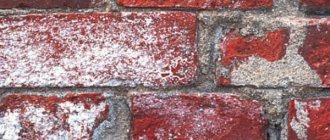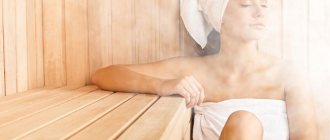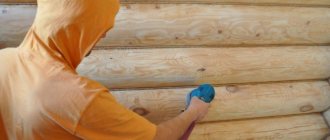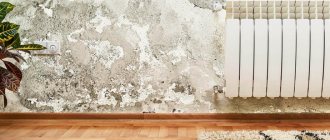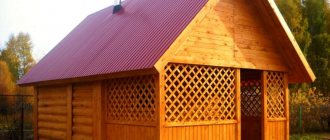Covering a house with facing bricks is not an easy task, but with proper installation and compliance with masonry rules, you can achieve reliable, durable protection of the building.
An important component of high-quality brick cladding is the brick itself: its structure, composition.
Brick can be of different colors, sizes and shapes, differs in production method and technical characteristics.
The cladding after installation does not require additional care or further maintenance.
Brickwork can last for many years, maintaining its original performance characteristics.
What is efflorescence
The most unpleasant thing that can happen to brick cladding is efflorescence. These are salt stains that form on the front surface of the brick . Moisture moves inside the material along with salt deposits, which evaporate in dry weather, and salt crystals are brought to the surface.
This spoils the appearance of the cladding: white stains and a whitish coating form on its surface.
In addition to spoiling the appearance of the cladding, efflorescence can lead to the destruction of bricks . Due to the increase in salt crystals inside the material, pores form and expand, which subsequently form cracks.
Briefly about the main thing
To make the wall look like new always, and not just in the first months after construction, you must:
- Comply with all technological requirements for choosing a brick and store it under a film to protect it from rain or snow;
- Prepare a solution with a minimum of additives, river (or washed quarry) sand and water purified from salts;
- Observe the climatic and weather conditions of construction, installation and drying;
- Promptly clean the facade from emerging stains and protect the brickwork with a water-repellent agent from exposure to water.
You need to understand the causes and consequences of the appearance of efflorescence, that this is not some kind of problem that appears randomly, but a harsh reality that needs to be dealt with not later, but to organize the construction process in such a way as to avoid the very causes of salt deposits. It depends only on you what the appearance of the brickwork will be.
Ratings 0
Causes
The main reason for the formation of efflorescence on brickwork is the crystallization of soluble substances that are part of the raw materials for bricks and the mortar. In this case, the brick can be anything: ceramic, clinker or silicate.
The process of formation of excess salts occurs as a result of increased water absorption of the facing material. As a result of high humidity inside the brick in cold weather, water freezes in the structure of the material, which leads to its destruction .
Efflorescence indicates that the surface of the brickwork requires measures to protect the surface from excessive exposure to water. To do this, it is necessary not only to cover the surface with protective agents, but also to check the canopies, roof, and window sills for leaks, as a result of which water gets onto the wall.
The following factors may be the causes of efflorescence beyond a person’s control::
- the sand that is used to prepare the solution may be oversaturated with salts due to the lack of measures to wash it during the extraction process;
- the presence of salts in the composition of raw materials for the production of ceramic blocks contributes to high moisture absorption due to the porous structure of the material;
- the presence of a large amount of salts in the water used for the production of bricks or concrete mixtures;
- groundwater;
- location of the premises next to a chemically hazardous enterprise, due to which natural precipitation carries aggressive substances.
There are other reasons why salt stains may occur on the surface of brickwork.:
- improper preparation of the solution in violation of the proportions, in which excess water predominates;
- poor quality material;
- use of cement-lime (or lime) mixtures;
- poor quality waterproofing;
- lack of protection from snow and rain.
CAREFULLY!
Low air temperature, at which crystallization of salts occurs, and a predominantly humid climate are a comfortable environment for the formation of efflorescence.
Therefore, in areas where rain prevails, and in the autumn-winter period the temperature drops below -5°C, the appearance of efflorescence is almost inevitable.
Preventive action
It is easier to foresee any problems in advance than to deal with them later. All products used should be taken only from trusted manufacturers who do not violate technology.
It is known that there are additives that allow you to save energy when firing bricks. It is beneficial for enterprises to use them, especially in the production of clinker products, but quality suffers as a result and efflorescence appears.
To reduce the dissolution of salts in the brick mass, special plasticizer compounds are used. Centuries ago, various natural substances, such as chicken eggs, were used to increase plasticity. Modern products include different components, among which the following are most often used:
- petroleum products;
- higher fatty acids;
- natural resins;
- synthetic organosilicon compounds.
The timeliness of plastering of the masonry is of great importance. If you start plastering damp walls from the inside without waiting for complete drying, then in the spring stains may appear on the outside.
The cause of efflorescence on bricks can be construction work carried out during the wet season. If it starts to rain, the masonry must be covered with protective polymer sheets, preventing it from getting wet.
Before starting work, bricks should not be kept in water for a long time. Using too thin a mortar for laying also increases the likelihood of efflorescence on the brick.
When drawing up a house project, the climate and soil composition must be taken into account. This will allow for the need to protect the walls from getting wet. The foundation must be properly protected with a horizontal waterproofing layer. There must be a gap between the walls, insulation and cladding for ventilation. For finishing facades, dry mixtures are preferred, which must be diluted with water in strict accordance with the manufacturers' recommendations.
There can be many reasons for the appearance of efflorescence. Understanding the problems will help you avoid or reduce the number of defects.
Why delete
A visible feature of efflorescence is the unsightliness of the front surface of the cladding. However, a more significant problem with efflorescence is the destruction of the brick structure . The front surface of the material first becomes scaly, and then large cracks form, which lead to the destruction of the block.
In this way, the entire facing masonry deteriorates not only in terms of external characteristics, but also its integrity is destroyed, which leads to a decrease in its heat-saving indicators, protective properties and other qualities.
It is especially important to take care of the brick if insulation is laid between the facing masonry and the load-bearing wall : if the lining is destroyed, the insulation may become unusable, especially if the cause of efflorescence is poor-quality waterproofing.
What is the danger of efflorescence?
@center-esm.ru
The substances contained in them destroy the structure of the brick. Over time, when struck, it becomes like a husk and crumbles.
The process leads to a lack of strength, and this threatens the destruction of the building.
Wet brick elements are unpredictable not only in terms of danger. They also carry a violation of hygiene - the formation of fungal deposits, microbes and mold. This habitat is attractive to many species of harmful insects.
Reference! Clinker bricks are not susceptible to efflorescence; salts and sulfates are not used in its production.
How to remove efflorescence on brick
Efflorescence is a rather poorly soluble structure, since the whitish coating may contain sulfate-sodium compounds, carbonate-sodium, carbonate-calcium. In addition, efflorescence may include aluminum, silicon, and iron-containing inclusions.
As a result of exposure to atmospheric and industrial emissions, soluble salts become insoluble, which significantly complicates their removal.
The tasks in eliminating efflorescence are:
- plaque removal;
- preventing salt from escaping from the material;
- protection of walls from further formation of efflorescence.
Technological means for cleaning walls from whitish deposits are solutions of acids based on phosphoric acid, hydrochloric acid and others.
NOTE!
When choosing an efflorescence remover, you should test it on a small surface.
Since certain drugs may not be suitable for every chemical composition, it is recommended to use universal products.
To remove efflorescence, you can use sprayers, rollers, and stiff brushes. Since the prepared solutions contain active chemicals, gloves and protective masks must be worn to keep the skin of your hands and face safe.
As a rule, acid solutions are applied to the wall and then, after some time, washed off. First, the wall is cleaned with a spatula, thick layers of plaque are knocked off, and then a solution is applied.
Sometimes it is possible to remove plaque using hot water and a brush, but this method is not effective enough: plaque can remain in seams and hard-to-reach places.
In some cases, chemicals based on organic and inorganic acids do not help. You can try to prepare your own compositions for removing efflorescence from brick walls.
How to clean tiles or paving stones?
Tiled spaces will look neat only with regular maintenance; even completely new tiles need to be cleaned of cement that has adhered during laying work.
As the tiles are used, contaminants of various origins accumulate on them. This could be spilled car oil, efflorescence, ingrown moss, or dirt and dust. The resulting stains spoil the beauty of the tiles, giving them a sloppy appearance. Timely cleaning helps remove absorbed dirt and extend the life of the coating. Each type of stain has its own optimal product and method of working with it.
From cement after laying
The first problem associated with contamination of the tile covering often occurs immediately after it is laid. During work, especially when the tiles get wet, cement may stick to them. It soaks into porous surfaces and leaves unsightly stains. They are especially noticeable on colored tiles.
However, do not be discouraged. Cement deposits can be easily removed by hand. To clean, you will need a simple home remedy - 9% table vinegar and a wire brush. The principle of action of acetic acid is that it destroys the lime contained in cement. Once in contact with acid, cement is easier to remove mechanically using a brush.
From dirt and dust
As a rule, the source of dirt and dust is bare areas of soil that are located near the paved sidewalk. Soil particles and grains of sand are carried with the shoes of pedestrians and the wheels of vehicles. To remove dust, the tiles are washed with water supplied under high pressure from a hose. If dust is strongly embedded in a rough surface, it can be removed using a stiff brush, such as a metal brush. The result will be better if you add a small amount of liquid soap to the water.
From grease stains and bitumen
Greasey contaminants remain when oils come into contact with them. The most common culprits for the appearance of greasy stains on tiles are cars. Engine oil that spills from them leaves permanent stains that cannot be washed off with water. How can you get them off the sidewalk?
There are several methods:
- washing with a soda solution using a brush;
- sandblasting;
- burning the oil with a gas burner, followed by cleaning the surface with an iron brush.
You can try to remove black bitumen stains mechanically by treating the surface with a metal brush. Bitumen dissolves well with acetone and white alcohol, but this cleaning method should not be used. The mixture of bitumen and solvent will penetrate even deeper into the porous structure and will be impossible to remove.
From white plaque (efflorescence)
Efflorescence is the name given to plaque formed when salt solutions of various compositions that have been absorbed into tiles dry out. The origin of efflorescence may vary.
Sources of efflorescence:
- salts present in the concrete mixture from which the tiles are made;
- salts that came from the solution used during installation;
- reagents that are used to sprinkle streets in winter when there is ice;
- groundwater of increased hardness;
- melt and rain water with salt impurities.
Externally, efflorescence looks like whitish streaks or spots on the surface of the tile. They consist of salts that are insoluble in water, so they cannot simply be washed off. An acidic environment is needed to dissolve salt deposits. It is created by adding acetic, citric or hydrochloric acid to water
The latter is a strong acid, so it should be used with caution
Another option for cleaning efflorescence involves using biodegradable detergents. An example of such a product is HG cleaning solution for paving stones. Its components disintegrate in the external environment without causing harm to nature. The optimal ratio of product and water is 1:10.
From moss
Moss growths usually appear in conditions of humidity and lack of sunlight. They not only spoil the appearance of the path, but also make it slippery. You can remove moss from the tiles with a brush and pressurized water, but the moss can quickly grow back. If possible, you should provide access to the surface of the sun path (cut off overgrown bushes) and eliminate contact with moisture (repair a leaking drain, improve drainage).
Moss spores remaining in crevices can be destroyed by treating problem areas with a chlorine-containing solution. Chlorine is poisonous and harmful to nature, so such treatment should be carried out extremely carefully, using a spot method. The solution is applied to the surface using a spray bottle. Colored tiles may fade when exposed to chlorine, so it is better to use herbicides when working with them.
Folk removal remedies
Experienced craftsmen effectively use some recipes to remove white plaque. Self-prepared solutions contain acids that can be purchased at pharmacies or hardware stores.
The most common recipes for removing plaque:
- hydrochloric acid solution (2-4%). You should moisten the wall with water, apply an acid solution, and after 10 minutes rinse with a strong stream of water;
- Apply acetic acid solution to the surface of the brick wall, rinse with water after 10 minutes;
- Apply ammonia to the surface, after some time rinse with a stream of water using brushes.
Some expert advice is based on mechanical scraping of plaque from the surface.
IMPORTANT!
When scraping off thick layers of efflorescence, you should not use metal spatulas, so as not to damage the front surface of the brick.
For this you should use wooden materials.
After the efflorescence has been removed, care should be taken to protect the walls to prevent the reappearance of salt stains on the wall.
Cleaning bricks from mortar. Water and high pressure
Let's consider how to clean brick from mortar and efflorescence, as well as other simple stains. Water can solve these problems perfectly. Excellent results can be achieved by directing the flow to the surface under high pressure.
Washing a wall with water pressure Source waterproofing.su
The jet softens and washes away the cement mortar if it is not in a too thick layer. It copes well with salt secretions, but with a small caveat. The wall must be dried after this treatment. Otherwise, increased humidity on the surface will again provoke the release of salt.
For drying, you can use the same high pressure. Just use hot air, not water. The compressed atmosphere will remove all moisture from the surface of the brickwork to the last drop. This treatment after washing will prevent dust from sticking to the wall. And it will retain its aesthetic appearance for a long time.
If you add chemicals to the liquid, you can easily deal with stains from petroleum products and traces of corrosion. But this will be discussed in more detail later.
Application of sandblasting
The same air stream and under the same high pressure. But along with it, it carries abrasive powder into the nozzle. And the latter easily copes with almost all contaminants.
Using hardware technology, bricks are cleaned from:
- traces of fuel oil;
- old paint;
- splashes of cement or bitumen;
- traces of corrosion;
- mold and lichens.
Sandblasting of brick walls Source alp-ur.ru
Moreover, the surface becomes perfectly clean. The main thing is not to exceed the pressure in the device. Otherwise, grains of abrasive may leave marks on the brick itself.
But such cleaning can be carried out in different ways. In the classic version, only dry sand is used. But if the contamination of the walls is large-scale, then the abrasive material is pre-wetted. This enhances the stripping effect.
You can also sandblast with either ice or fire. In the first case, cleaning is considered the most environmentally friendly. And small sharp pieces of ice can remove dirt from even the smallest cracks. The fire method guarantees the complete removal of all parasites from the wall. From ordinary mold to the longest lichen roots.
Mechanical method
We are talking about chipping away smudges of mortar with hand tools. But while ceramic bricks can still be cleaned with a regular scraper or hammer and chisel, silicate bricks will require considerable effort.
Beating off old plaster Source fasad-exp.ru
Due to the increased adhesion of the surface, sometimes it seems as if the brick and mortar are one whole. Therefore, instead of a hand tool, only an electric one will help here. Rotary hammers with pointed tips and grinders with metal brushes will be able to separate one from the other faster and more efficiently than a regular chisel.
The stage of mechanical chipping is completed by sanding with sandpaper. Moreover, for bricks you can take material with large grains. And after completing all operations, it is necessary to rinse the treated surface with water to remove all dust from it.
Protecting the wall from efflorescence
You can protect brick cladding from the appearance of efflorescence at the stage of purchasing materials. should purchase bricks from quality manufacturers, use only dry mixtures and prepare the mortar strictly according to the instructions using salt-free water . Take care of vertical waterproofing. Cover the surface after installation with protective agents.
After removing any efflorescence, dry the wall and then treat the surface with a hydrophobic agent. It is advisable to choose a deep penetration composition: it will prevent the crystallization of salts inside the brick. The water repellent has water-repellent properties and protects the wall from moisture.
The water repellent is applied to the surface with a brush . Sometimes a two-layer application is required.
The service life of the protective coating is six years or more. This protection is provided due to the deep penetration of the water-repellent mixture into the structure of the brick.
We recommend
Impregnation for stone DOCKER GIDROFOB It is used for effective protection of facades (efflorescence, moisture, atmospheric pollution), as well as for waterproofing walls and concrete floors in damp and other rooms. Suitable for external and internal work. Without smell. No acid. “Dry wall” (there is no “wet stone” effect). Prevents the appearance of efflorescence Read more
How to wash off white plaque on brickwork How to remove plaque from brickwork
From plaster on brickwork
To properly remove plaster you need:
- Remove all furniture from the premises.
- Close all cracks tightly to prevent dust from entering other rooms.
- Prepare a hammer, chisel, brush.
- Remove the layer of plaster.
- Clean the wall from dust.
- Cover the surface with varnish.
Using a chisel and hammer, you need to remove the layer of plaster. You need to start from the top corner and gradually move down. The tool must be held at an angle.
During work, the plaster must be constantly removed from the room so that it does not accumulate underfoot and interfere with work. After upholstery, use a brush to remove all small particles and dust from the wall.
Then you need to wash the brick. Using a wet cloth, you need to clean the walls, starting from the top corner. To give brickwork a beautiful appearance, you can use a special varnish.
Is it possible to warn and how?
To prevent plaque from appearing on the material, you need to avoid laying it during rain.
- Do not lay masonry in cloudy or rainy weather, or with high air humidity.
- Follow the recommended norms for introducing antifreeze and other additives into the solution, make it a little tougher.
- Clean the sand.
- Initially, do not allow the bonding mixture to get on the masonry; if this happens, wipe it off.
- Use a special composition that repels water.
Procedure for removing efflorescence
There shouldn’t be any particular difficulties when working with cleaners, because each type comes with instructions. You just need to study it and follow the recommendations. Before starting the purification process, substances must be diluted with water in certain proportions. Next, the product is applied to the brick with traces of plaque using a brush or roller, and left for 30 minutes. Then the product is washed off the walls under the pressure of water.
When working with products for cleaning efflorescence on brickwork, be sure to wear protective clothing and glasses, remember that you are dealing with chemicals that can cause burns and irritation to the skin. To consolidate the result, treat the walls with a water repellent.
This is a special impregnation that prevents the re-formation of efflorescence on the brick. This is done immediately after the walls have dried, and it is best to wait until the cement in the newly built house has completely dried. That is, to carry out protective treatment at the final stage of construction of the building.
Means for removing efflorescence on bricks
Chemistry
- Neomid-550 for efflorescence is the most popular remedy. Works with stone, brick and concrete. Dilute in a 1:1 ratio with water or alcohol. Wall treatment is carried out at low air temperatures. The advantage of the product is that it is able to penetrate into the material and remove the salt, neutralizing it.
- Good Master is an acid-based anti-efflorescence product. Allows you to remove any type of salts from any material, and does not require dilution.
- Aqua cleanses of dirt, plaque and deposits. Removes cement residues from walls, fungus and mold. Cannot be used on limestone and marble surfaces.
- Tverdolite-Anti-efflorescence is a special additive that is mixed into cement to prevent the formation of efflorescence on the masonry.
- Silicone water repellent – a product for treating brick walls. Promotes the formation of a protective film of silicone on the surface, which prevents the penetration of moisture into the material. In addition, a very important nuance is that the composition of the product does not complicate gas exchange, helping the walls to “breathe”. Protection against efflorescence on bricks from the manufacturer – about 10 years. Re-application is done if necessary, if you notice the walls getting wet.
Folk remedies
Fighting efflorescence on the walls can be done from what you have at hand. Regular table vinegar diluted with any cleaning product will help you with this. Also, ammonia and hydrochloric acid work well.
Efflorescence on red brick
Bright red facing bricks are most susceptible to efflorescence due to their composition. This is due to the high iron oxide content. In order to remove efflorescence from this material, you can use the following methods:
- Treatment with vinegar removes easily soluble salts.
- Brushes and detergents paired with demineralized water.
- Light phosphoric acid solution.
- Modern products containing the substance trilon-chelaton III.
Note.
The substance Trilon-chelaton III can cause irritation to the lungs, eyes and skin, so all work is carried out in protective clothing and glasses. The walls are washed after treatment under high water pressure using a Karcher installation.
You need to work with facing bricks carefully. Because with careless rough handling there is a risk of washing out the coloring components, and the material will subsequently resemble a spotted camouflage net.
Removing salts from masonry
To complete the information, it should be noted that salt does not always appear on the masonry solely due to the absorption of atmospheric moisture. Additives added to the solution - antifreeze or accelerating setting - may also be to blame. The water used for mixing and the quality of the sand, which must be washed, are of great importance.
Capillary absorption of moisture occurs primarily due to the absence of layers of rolled waterproofing material between the base of the foundation and the basement wall, and between the base and the wall of the house. Moreover, this material should not be laid dry - it should be glued to bitumen mastic.
Usually this is a whole complex of factors that lead to the same result. People who do construction with their own hands do not always know about such seemingly trifles, or simply do not attach importance to them. And then they rack their brains: “How to remove efflorescence on brick?” It’s good that there are means that allow you to fight this, frankly speaking, unaesthetic phenomenon.
All means are good to fight
Before discussing the process of cleaning masonry, let's figure out how to remove efflorescence on brick. It is impossible to do this without a special tool.
Well, you wash the facade, and salt deposits will appear again and again - and this will continue until you do everything right. Let's see what the retail network offers us for this purpose.
- One of the most popular brands of products intended for cleaning efflorescence is Neomid-550. This is a universal option that can be used not only for brick, but also concrete and stone surfaces.
- The concentrated composition is diluted in half with water before removing efflorescence on the brick. If cleaning must be done at sub-zero temperatures, alcohol can be used instead of water. It is packaged in bottles with a capacity of 1 l, 3 l and 5 l, and costs approximately 400 rubles. per liter
How to remove efflorescence on facing bricks: anti-salt Neomid -550
- The composition produced under the Good Master brand is equally effective and inexpensive. It penetrates deeply, dissolves and removes salts from the pores. Perfectly removes even old plaque. Packaged in 5l and 10l canisters, cost 450 and 860 rubles. respectively. It does not require dilution, as it is already ready for use. Unlike the previous option, it contains acid and removes all types of salts.
- The “Anti-vysol Aqua” product is generally a universal cleaner. It is effective not only against soluble salts, but also against sulfate and carbonate deposits, so it can be used not only to remove efflorescence, but also to clean the facade from traces of masonry mortar.
The drug is also active against fungus and mold, which greatly simplifies the task, eliminating the need to also buy a biocide. With the exception of limestone and marble, it can be used to treat any surface.
The cleaner is ready for use, packaged in plastic containers of 5 liters and 10 liters, and costs around 300 rubles. per liter
Masonry processing process
There are a lot of products designed to remove salts - we have presented only a small overview. As for the process of applying them, no matter which option you choose, the processing is carried out in the same way.
First, the wall must be prepared by cleaning the flaking areas of the masonry from pieces and crumbs of brick, as well as using a metal brush to treat those places where there are significant salt deposits. They need to be cleaned off so that only whitish spots remain.
Cleaning brick walls
If the salt cleaner works effectively, within a couple of minutes the treated area will become clean. Apply such compositions as a regular primer - with a roller or brush. You can also use a spray bottle, but then the consumption will be slightly more than stated by the manufacturer.
After waiting the prescribed number of minutes after applying the drug, it should be rinsed with water from a hose with good pressure. Then, the walls need to be allowed to dry, and the protective silicone impregnation mentioned above can be applied.
From paint
If the brick wall was painted, but began to peel off over time, then you need to urgently remove the old paint. The modern method of sandblasting walls is often used. But this may damage the material.
Therefore, it is best to adhere to the following recommendations:
- Perform initial paint removal.
- Get rid of fungus.
- Perform chemical treatment.
- Perform secondary paint removal.
The second stage is getting rid of the fungus. A special solution is prepared (bleach and water in a ratio of 3:1) and applied to the wall with a brush. After this, rinse thoroughly with water.
When the wall is completely dry, another solution is applied to it, which removes the remaining layer of paint chemically: caustic soda and water in a ratio of 1:3.
A small amount of flour is gradually added to this solution until it becomes mushy.
The prepared solution is applied to the wall with a spatula and left for 2 days. After this, warm water from a hose (under high pressure) removes the solution from the surface along with the old paint.
If you need to clean a wall in your house, then while applying the solution to the walls, strips of paper are glued to it. It is then removed from the surface along with the paint.

